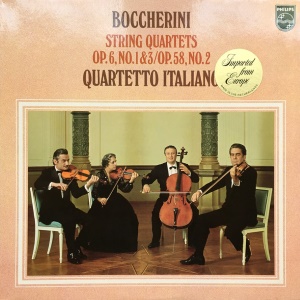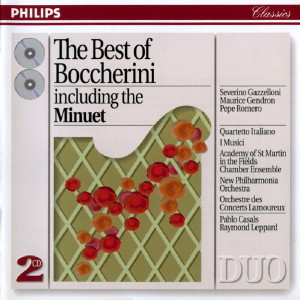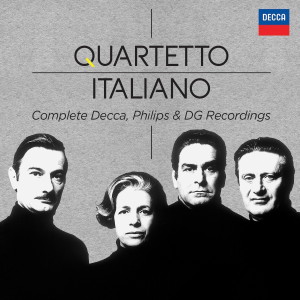 |
|
Philips
- 1 LP - 9500 305 - (p) 1977
|
 |
| Philips
DUO - 2 CDs - 438 377-2 - (c) 1993 |
 |
| Decca -
37 CDs - 478 8824 - (c) 2015 |
|
| Luigi Boccherini
(1743-1805) |
|
|
|
|
|
|
|
| String
Quartet in D minor, Op. 6 no. 1 (G
165) - (Op. 8 no. 1 in
Boccherini's autograph catalogue) |
|
18' 06" |
|
-
Allegro vivace
|
5' 40" |
|
|
-
Adagio
|
8' 50" |
|
|
| -
Minuetto in Rondeau |
3' 36" |
|
|
|
|
|
|
| String
Quartet in E flat major, Op. 6 no.
3 (G 167) - (Op. 8 no. 3 in
Boccherini's autograph catalogue) |
|
18' 58" |
|
| -
Largo |
9' 06" |
|
|
| -
Tempo di Minuetto |
5' 46" |
|
|
| -
Allegro |
4' 06" |
|
|
|
|
|
|
| String
Quartet in E flat major, Op. 58
no. 2 (G 243) |
|
21' 19" |
|
-
Allegretto lento
|
7' 15" |
|
|
| -
Menuetto: Allegro |
4' 18" |
|
|
| -
Larghetto |
4' 55" |
|
|
| -
Finale: Allegro vivo assai |
4' 51" |
|
|
|
|
|
|
QUARTETTO ITALIANO
- Paolo Borciani, Elisa Pegreffi, violino
- Piero Farulli,
viola
- Franco Rossi, violoncello
|
|
|
|
|
|
Luogo e data
di registrazione |
|
Doopsgezinde
Kerk, Amsterdam
(Olanda) - 8-13
novembre 1976 |
|
|
Registrazione: live
/ studio |
|
studio |
|
|
Producer / Engineer |
|
Vittorio
Negri
| Willem
van Leewen |
|
|
Prima Edizione LP |
|
Philips | 9500
305
| 1
LP | (p) 1977
|
|
|
Prima Edizione CD |
|
Philips
DUO | 438
377-2
| 2
CDs - 76'
42"
- 71' 17" (1°,
8-10)
| (c) 1993
| ADD | (Op. 6 no.
1)
Decca
| 478 8824 | 37 CDs -
(18°, 1-3, 4-6, 7-10)
| (c) 2015
| ADD |
|
|
Note |
|
-
|
|
|
|
|
When Luigi
Boccherini, working from
Madrid, entered the
international music
world with his string
quartets and
particularly his string
quintets, the Rococo was
flourishing in Spain.
The paintings of the
young Goya, and
especially his cartoons
for the royal tapestry
factory, show a lucid
harmony of colours. In
these works Goya painted
the people, in Sunday
clothes and at play.
Human and social
problems had not yet
entered his canvases.
Likewise, Boccherini's
chamber music has none
of the psychological
depths which draw
Mozart's quintets into
the spiritual centre of
his late chamber works.
Boccherini's
compositions represent
entertainment music in
the best sense of the
word - entirely centred
on virtuoso playing, dolcezza,
and the most delicate
colour and charm.
Luigi
Boccherini, born in
Lucca as the son of a
double-bass player,
passed his childhood
in modest
circumstances. At the
age of 13 heappeared
locally in public as a
cellist, and after a
period of study in
Rome he returned to
Lucca to play his
instrument in the
theatre orchestra. The
young virtuoso did not
stay for long within
the marrow bounds of
his native town.
Concert tours with the
violinist Filippino
Manfredi took him to
Vienna and Paris,
where he played at the
famous Concert
Spirituel and
published his first
chamber works. At the
suggestion of the
Spanish ambassador in
Paris, he travelled to
Madrid in 1769
and subsequently
became chamber
composer and
virtuoso to the Infante Don
Luis.
Boccherini
established a
close connection
with the
cello-playing
Prussian king
Frederick
William II, for
whom he wrote a
good deal of
chamber music
and from whom he
received a
salary for a
number of years.
There is also
evidence that he
visited Germany.
nonetheless
Boccherini
remained in the
end faithful to
his adopted
country, Spain
where in later
years, he was
patronised for a
time by Lucien
Bonaparte,
ambassador of
the French
Republic at the
court of Madrid,
and also by the
Marquis
Benavenue.
Towards the end
of his life,
however, his
reduced
circumstances
were only
briefly relieved
by rich and
influential
patrons, and
although his
name had been enthablished
in
the musical
world, chiefly
through Paris
publicationes
of his works,
he died in
Madrid in 1805
in poverty.
"As
a poem, as a
dream and a
perfume" was
how
Boccherini's
music appeared
in 1805 to the
French
easthete Chènedollé.
Soon, however,
in the
Romantic
nineteenth
century, is
fell into
oblivion,
until in the
1870's the
famous Minuet
was
rediscovered,
and a hitherto
unknown
quintett movement
inundated by a
wawe of
popularity. At
the same time
as Tchaikovsky
was paying
homage to
Mozart in his
"Rococo"
Varitaions,
and Camille
Saint-Saëns
was declaring
his love of
the galant
style in the
minuet of his
A minor Cello
Concerto,
people were
discovering in
Boccherini's
Minuet (soon
made widely
accessible in
countless
transcriptions)
a jewel of
Rococo art.
Some years
later, in
1895, the
Dresden
cellist
Friedrich Grützmacher
brought out
his very free
arrangement of
the Cello
Concerto in B
flat, and for
a long time
Boccherini was
generally know
- apart from
the Minuet -
solely as the
composer of
this work.
Only much
later did
musicians and
their
audiences
become aware
of the rich
treasure which
lay in the
many string
quartets and
quintets (with
two cellos).
The
string
quartets of
Op. 6 (this
according to
Boccherini's
own work
catalogue -
they are
designated Op.
8 in the
catalogue of
Yves Gérard,
published in
London in
1969) were
dedicated to
the Spanish
Infante Don
Luis and
printed in
Paris in 1769.
The following
year they
appeared in
London and
finally
probably in
1780, an
Amsterdam. The
young
Boccherini
would have
been well
satisfied with
this reception
of his chamber
music.
Delicacy
and
sensitivity
blend with
elements of galant
style in the
quartets of
Op. 6. Each
has three
movements, but
the form and
character of
the movements
and the
sequence in
which they
occur are
subject to no
fixed norm. In
the D major
Quartet Op.6
No. 1, an Allegro
vivace
with a
virtuoso
first-violin
part is
followed by an
affecting Adagio
in D minor,
and a graceful
Rondeau Allegro
in minuet
character. In
the E flat
Quartet Op. 6
No. 3, there
is an
introductory Largo
and the a Tempo
di Minuetto
and an Allegro.
In
Boccherini's
Op. 6 dolce
is the
frequently
encountered
expression
mark of a
Rococo art. So
too is the
indication lezioso
(daintly) over
a passage in
the first
movement of
the first
quartet.
Three
decades lie
between the
pubblication
of Op. 6 and
the six
quartets of
Op. 58, which
were issued in
Paris in 1799.
In all that
intervening
time,
Boccherini's
early
established
quartet style
underwent only
very slight
modifications.
In op. 58,
however, he
follows a new
path. Ludwig
Finscher
writing on
string
quartets in "Musik
in Geschichte
und
Gegenwart,"
traces the
orchestral richness
of sound, the
emotional
tension, and
the tendency
to extreme
effects
(semitone
progressions,
violent
dynamic
contrasts) to
the influence
of the music
of the French
Revolution on
quartet style
in general.
The E flat
Quartet, Op.
58 no. 2,
confirms this
total view of
Op. 58 in the
orchestral
tonal style of
many passages
and the close
justaposition
of stark forte
unisons and
light textured
piano
figures. The
minuet is
agitated by sforzati
on unaccented
beats, and the
closing Allegro
vivo assai
shows
some leanings
towards
contrapuntal
working.
Hans
Christoph Worbs
|
|
|